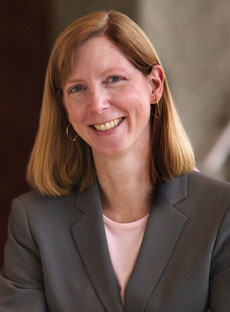Over the past two decades, China’s economy has grown rapidly and the nation has become a major destination for foreign direct investment. Surprisingly, however, relatively little of China’s FDI inflow comes from technologically advanced, dominant players in global investment, such as the United States, Europe and Japan (Prasad and Wei 2007 and Branstetter and Foley 2010). Moreover, while there has been an explosion of patenting in China by domestic applicants, FDI outflows from China to the United States, Europe and Japan remain small.

Thomas Holmes
In recent research published as Minneapolis Fed Staff Reports 486-488, we highlight the importance of China’s quid pro quo policy in understanding these FDI flows. Quid pro quo is a long-standing policy of China requiring foreign firms to transfer technology to China in return for access to its market. We estimate that China has enjoyed significant gains from this policy, at the expense of countries doing FDI in China.
A key feature of quid pro quo deals is that typically the property rights being exchanged in a technology transfer transaction apply inside China, not outside. For example, GE might agree to a joint venture in China with a local partner in return for access to the Chinese market. GE will likely be required to transfer technology to the local partner, ensuring that the Chinese firm has ownership rights within China, though not abroad. In particular, if the Chinese partner attempts to sell goods based on this technology in the United States, GE will enforce its ownership rights in the United States to keep the Chinese company out.
This mechanism is at least qualitatively consistent with the observation of small bilateral FDI flows between advanced countries and China. The technology transfer requirement acts like a tax, making China a less attractive investment for a high-tech company like GE. Hence, inflows from advanced nations are lower than they would be otherwise. However, even these diminished transfers cumulate over time. We estimate significant total amounts transferred over the past 20 years.
The mechanism is also consistent with small outflows from China, especially to countries like the United States. If Chinese partners tried to sell in the United States, U.S. companies would use their ownership rights on the technology to block Chinese partners.
Evidence for the mechanism
Quid pro quo is a precondition for many multinationals to operate in China. Prior to China’s accession to the World Trade Organization, the policy was explicit (Walsh 1999). After accession, which prohibits technology transfer requirements for market access, quid pro quo became implicit policy, according to surveys of multinationals. For example, in its 2012 survey of members, the U.S.-China Business Council found that “85 percent of companies report that they are at least somewhat concerned about transferring technology to China” and “36 percent of respondents indicated they were asked in the past three years to make such a transfer as a requirement for gaining an investment, project, product or market entry approval” (U.S.-China Business Council 2012).

Ellen McGrattan
We provide new evidence about the terms of quid pro quo from patents filed in China by joint ventures (patents that list the name of both a foreign multinational firm and a local Chinese partner). We find from these examples that joint ownership of ideas within China does not extend outside China.
In the accompanying table, we analyze a sample of patents that were first filed in China. Column 1 shows the percentages of these patents that link outside China, as listed by owner. Row 1 considers patents jointly owned by a foreign multinational and a domestic partner. Row 2 shows patents owned by 114 large foreign multinationals, as ranked by domestic Chinese sales. Row 3 is for patents of the top 100 Chinese patenters.
We ask two questions about these patents. First, do the patents go outside China? We measure this by determining whether the same patent in China also has been filed as either a U.S. patent application or a World Intellectual Property Organization (WIPO) application. Second, in cases where patents go outside, are the Chinese firms included in the owner list on the outside applications?
In terms of the first question, we find that the fraction of jointly owned patents first filed in China that go outside is only 1.5 percent. In contrast, 10.1 percent of the Chinese patents owned by the foreign multinationals and 16.5 percent owned by the top Chinese patenters are also linked to patent applications outside China. Thus, there is a striking difference between patents that are shared and those that are not shared.
As to the second question, we find that of the patents shared in China that do go outside, in most cases (87 percent), the Chinese firm that is a co-owner of the patent in China is dropped from the ownership list in the patent that goes outside China.
As one example, for the joint venture between telecommunications multinational Alcatel-Lucent and Chinese firm Shanghai Bell, 97 of their jointly owned patents went outside China in the form of WIPO applications. Nearly all (92) of those applications specified that Shanghai Bell shared ownership only in China, with Alcatel-Lucent the sole owner in all other countries.
Quantitative impact of quid pro quo policy
Inferring the quantitative impact of quid pro quo policy requires working out the implications of an economic model because much of what is transferred from multinationals to Chinese partners—something we call technology capital—is difficult to measure directly.

Edward Prescott
Technology capital is nonrivalrous capital that can be used across locations; once a firm makes an investment in technology capital in its home country, it can take that technology capital to other markets as countries open up to FDI inflows. Examples include accumulated know-how from investments in R&D, brands and organizations that are not specific to any one establishment or location. For the most part, these investments are not included in national accounts, but magnitudes can be inferred if we assume that multinationals invest only to the degree that it is profitable to do so.
We incorporate technology capital and its potential transfer through quid pro quo arrangements into a multicountry model that includes China, the United States, Europe, Japan and other countries that have significant investments in China. We assume that the quid pro quo arrangements restrict property rights outside China.
We then compare a version with the policy to a version without it. In both versions, parameters are chosen so that predictions about country gross domestic products (GDPs) and total inward foreign investments match magnitudes and trends seen in the data.
There are two main findings. First, we find that even though FDI flows into China have been small from the United States, Europe and Japan, the model predicts a significant volume of foreign technology capital is accumulated by China over the period 1990-2010, with the stock at close to three times the capital stock arising from investments in technology capital made by domestic Chinese firms.
Second, we find that the welfare gains of following the policy have been high for China, about 4.5 percent per year in annual consumption. In contrast, for countries that invest in China, the policy has led to welfare losses when compared with the alternative case in which technology transfer is not a precondition to investing in China. For example, U.S. and European losses are around -0.5 percent per year in annual consumption with a quid pro quo requirement in place.
It is no surprise, then, that China continues to promote quid pro quo policy, at least implicitly, while other nations insist that it be prohibited.
(Editor’s note: A version of this Research Digest appears on voxeu.org.)
References
Branstetter, L., and C. F. Foley. 2010. “Facts and Fallacies about U.S. FDI in China.” In China’s Growing Role in World Trade, edited by R. C. Feenstra and S.-J. Wei. Chicago: University of Chicago Press.
Holmes, T. J., E. R. McGrattan and E. C. Prescott. 2013. “Quid Pro Quo: Technology Capital Transfers for Market Access in China.” Research Department Staff Reports 486-488, Federal Reserve Bank of Minneapolis.
Prasad, E., and S.-J. Wei. 2007. “The Chinese Approach to Capital Inflows: Patterns and Possible Explanations.” In Capital Controls and Capital Flows in Emerging Economies: Policies, Practices, and Consequences, edited by S. Edwards. Chicago: University of Chicago Press.
U.S.-China Business Council. 2012. USCBC 2012 China Business Environment Survey Results and Supplement, uschina.org.
Walsh, K. A. 1999. “U.S. Commercial Technology Transfers to the People’s Republic of China, A Report to the Office of Strategic Industries and Economic Security.” Bureau of Export Administration, bis.doc.gov.








